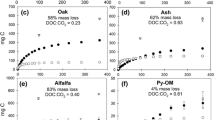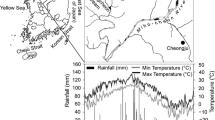Abstract
Decay processes in an ecosystem can be thought of as a continuum beginning with the input of plant litter and leading to the formation of soil organic matter. As an example of this continuum, we review a 77-month study of the decay of red pine (Pinus resinosa Ait.) needle litter. We tracked the changes in C chemistry and the N pool in red pine (Pinus resinosa Ait.) needle litter during the 77-month period using standard chemical techniques and stable isotope, analyses of C and N.
Mass loss is best described by a two-phase model: an initial phase of constant mass loss and a phase of very slow loss dominated by degradation of ‘lignocellulose’ (acid soluble sugars plus acid insoluble C compounds). As the decaying litter enters the second phase, the ratio of lignin to lignin and cellulose (the lignocellulose index, LCI) approaches 0.7. Thereafter, the LCI increases only slightly throughout the decay continuum indicating that acid insoluble materials (‘lignin’) dominate decay in the latter part of the continuum.
Nitrogen dynamics are also best described by a two-phase model: a phase of N net immobilization followed by a phase of N net mineralization. Small changes in C and N isotopic composition were observed during litter decay. Larger changes were observed with depth in the soil profile.
An understanding of factors that control ‘lignin’ degradation is key to predicting the patterns of mass loss and N dynamics late in decay. The hypothesis that labile C is needed for ‘lignin’ degradation must be evaluated and the sources of this C must be identified. Also, the hypothesis that the availability of inorganic N slows ‘lignin’ decay must be evaluated in soil systems.
Similar content being viewed by others
References
Aber J D and Melillo J M 1980 Litter decomposition: Measuring relative contribution of organic matter and nitrogen to forest soils. Can. J. Bot. 58, 416–421.
Aber J D and Melillo J M 1982 Nitrogen immobilization in decaying hardwood leaf litter as a function of initial nitrogen and lignin content. Can. J. Bot. 60, 2263–2269.
Anonymous 1976 Alcohol-benzene and dichloromethane solubles in wood and pulp. T204-OS-76. Technical Association of the Pulp and Paper Industry. Atlanta, Georgia, USA.
Anonymous 1977 Individual/simultaneous determinations of nitrogen and/or phosphorus in BD acid digests. Industrial Method Number 329-74 W/B. Technicon Industrial Systems, Tarrytown, New York, USA.
Benner R, Fogel M L, Sprague E K and Hodson R E 1987 Depletion of13C in lignin and its implications for stable carbon isotope studies. Nature 329, 708–710.
Berg B and Staaf H 1981 Leaching, accumulation, and release of nitrogen in decomposing forest litter.In Terrestrial Nitrogen Cycles Eds. F E Clark and T Rosswall. pp 163–178. Ecological Bulletin, Volume 33, Stockholm, Sweden.
Bocock K L, Gilbert O, Capstick C K, Twinn D C, Ward J S and Woodman M J 1960 Change in leaf litter when placed on the surface of soils with contrasting humus types. I. Losses in dry weight of oak and ash leaf litter. J. Soil Sci. 11, 1–9.
Bunnell F L, Tait D E N, Flanagan P W and Van Cleve 1977 Microbial respiration and substrate weight loss. I. A general model of the influences of abiotic variables. Soil Biol. Biochem. 9, 33–40.
Bunnell F L and Tait D E N 1977 Microbial respiration and substrate weight loss. II. A model of the influences of chemical composition. Soil Biol. Biochem. 9, 41–47.
Crawford R L 1981 Lignin Biodegradation and Transformation. John Wiley and Sons, New York 154 p.
Drew S W and Kadam K L 1979 Lignin metabolism byAspergillus fumigatus and white rot fungi. Deo. Ind. Microbiol. 125, 227–332.
Dubois M K, Gilles K A, Hamilton J K, Rebers P A and Smith F 1956 Colorimetric method for determination of sugars and related substances. Anal. Chem. 28, 350–356.
Dzurec R S, Boutton T W, Caldwell M M and Smith B N 1985 Carbon isotope ratios of soil organic matter and their use in assessing community composition changes in Curlew Valley, Utah. Oecologia 66, 17–24.
Effland M J 1977 Modified procedure to determine acid soluble lignin in wood and pulp. TAPPI 60, 143–144.
Ember L M, Williams D F and Morris J T 1987 Processes that influence carbon isotope variations in salt marsh sediments. Mar. Ecol. Prog. Ser. 36, 33–42.
Eriksson K E 1978 Enzyme mechanisms involved in cellulose hydrolysis by the white rot fungusSporotrichum pulverulentum. Biotech. Bioeng. 20, 317–332.
Fenn P, Chois and Kirk T K 1981 Lignolytic activity ofPhanerochaete chrysosporium: Physiology and suppression by NH +4 and L-glutamate. Arch. Microbiol. 130, 66–91.
Fogel R and Cromack K Jr 1977 Effect of habitat and substrate quality on Douglas fir litter decomposition in western Oregon. Can. J. Bot. 55, 1632–1640.
Howard P J A and Howard D M 1974 Microbial decomposition of tree and shrub leaf litter. I. Weight loss and chemical composition of decomposing litter. Oikos 25, 341–352.
Jansson P E and Berg B 1985 Temporal variation of litter decomposition in relation to simulated soil climate: Longterm decomposition in a Scots pine forest. V. Can. J. Bot. 63, 1008–1016.
Keyser P, Kirk T K and Zeikus J G 1978 Ligninolytic enzyme system ofPhanerochaete chrysosporium: Synthesized in the absence of lignin in response to nitrogen starvation. J. Bacteriol. 135, 790–797.
Kirk T K, Yang H H and Keyser P 1978 The chemistry and physiology of the fungal degradation of lignin. Dev. Ind. Microbiol. 19, 51–61.
Kirk T K and Farrell R A 1987 Enzymatic combustion: The microbial degradation of lignin. Annu. Rev. Microb. 41, 465–505.
Lyford W H 1963 Importance of ants to brown podzolic soil genesis in New England. Paper Number 7, Harvard Forest. Petersham, Massachusetts, USA.
Lyford W H 1964 Coarse fragments in the Gloucester soils of the Harvard Forest. Paper Number 9, Harvard Forest, Petersham, Massachusetts, USA.
Mariotti A, Pierre D, Vedy J C, Bruckert S and Guillemot J 1980 The abundance of natural nitrogen 15 in the organic matter of soils along an, altitudinal gradient (Chablais, Haute Savoie, France). Catena 7, 293–300.
Meentemeyer V 1978 Macroclimate and lignin control of litter decomposition rates. Ecology 59, 465–472.
Melillo J M, Aber J D and Muratore J F 1982 Nitrogen and lignin control of hardwood leaf litter decomposition dynamics. Ecology 63, 621–626.
Melillo J M, Naiman R J, Aber J D and Linkins A E 1984 Factors controlling mass loss and nitrogen dynamics of plant litter decaying in northern streams. Bull Marine Sci. 35, 341–356.
Minagawa M, Winter D A and Kaplan I R 1984 Comparison of Kjeldahl and combustion methods for measurement of nitrogen isotope ratios in organic matter. Anal. Chem. 56, 1859–1861.
Minderman G 1968 Addition, decomposition and accumulation of organic matter in forests. J. Ecol. 56, 355–362.
Nadelhoffer K J and Fry B 1988 Controls of natural15N and13C abundances in forest soil organic matter. Soil Sci. Soc. Am. J. 52, 1633–1640.
O'Brien B J and Stout J D 1978 Movement and turnover of soil organic matter as indicated by carbon isotope measurements. Soil Biol. Biochem. 10, 309–317.
Olson J S 1963 Energy storage and the balance of producers and decomposers in ecological systems. Ecology 44, 322–331.
Peterson B J and Fry B 1987 Stable isotopes in ecosystem studies. Annu. Rev. Ecol. Syst.
Reddy C A 1984 Physiology and biochemistry of lignin degradation. pp 558–571.In Microbial Ecology. Proc. 3rd Intl. Symp. Microb. Eds. M J Klug and C A Reddy. Am. Soc. of Microbiol., Washington, D. C.
Riga A, Van Praag H J and Brigode N 1971 Rapport isotopique naturel de l'azote de dans quelques sols forestiers et agricoles de Belgique soumis à divers traitements culturaux. Geoderma 6, 213–222.
Schleser G H and Bertram H G 1981 Investigation of the organic carbon and δ13C profile in a forest soil.In Recent Developments in Mass Spectrometry in Biochemistry, Medicine and Environmental Research. 7. Ed. Afrigerio. pp 201–204. Elsevier, Amsterdam.
Schleser G H and Pohling R 1980 δ13C record in a forest soil using a rapid method for preparing carbon dioxide samples. Int. J. Appl. Rad. Isotopes 31, 769–773.
Shearer G, Kohl D H and Chien S H 1978 The nitrogen-15 abundance in a wide variety of soils. Soil Sci. Soc. Am. J. 42, 899–902.
Smith W H 1969 Release of organic materials from the roots of tree seedlings. For. Sci. 15, 138–142.
Stout J D, Rafter T A and Troughton J H 1975 Possible significance of isotopic ratios in paleoecology. pp 279–286.In Quarternary Studies. Eds. R P Suggate and M M Cresswell. The Royal Society of New Zealand.
Swift M J, Heal O W and Anderson J M 1979 Decomposition in Terrestrial Ecosystems. University of California Press, Berkeley and Los, Angeles 362 p.
Waksman S A, 1926 On the origin and nature of the soil organic matter or soil ‘humus’ V. The role of microorganisms in the formation of ‘humus’ in the soil. Soil Sci. 22, 421–436.
Waksman S A and Stevens K R 1930 A critical study of the methods for determining the nature of abundance of soil organic matter. Soil Sci. 30, 97–116.
Waksman S A and Reuszer H W 1932 On the original of the uronic acids in the humus of soil, peat, and composts. Soil Sci. 33, 135–151.
Waksman S A, Tenney F G and Stevens K R 1928 The role of microorganisms in the transformation of organic matter in forest soils. Ecology 9, 126–144.
Author information
Authors and Affiliations
Rights and permissions
About this article
Cite this article
Melillo, J.M., Aber, J.D., Linkins, A.E. et al. Carbon and nitrogen dynamics along the decay continuum: Plant litter to soil organic matter. Plant Soil 115, 189–198 (1989). https://doi.org/10.1007/BF02202587
Issue Date:
DOI: https://doi.org/10.1007/BF02202587




